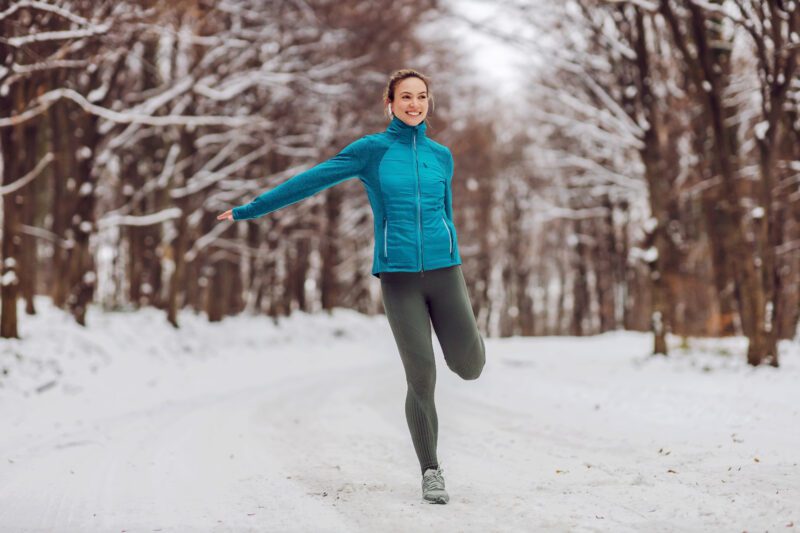
Colder weather means some changes to how we exercise. Of course, it’s harder to motivate yourself to get outside for a run or bike ride when the temperature drops, and the shorter days compress our schedules, but there are changes in your body that affect your ability to exercise too. For many people with arthritis or other joint problems, cold weather brings more complaints of pain.
To stay warm, our bodies narrow blood vessels to reduce blood flow to the skin, and more superficial muscles. That means that there is an increased risk of muscle strains in the cold. There is also an increased strain on the heart because of the narrowed blood vessels.
This isn’t to say that you shouldn’t be active outdoors in the cold, it just means you may have to make a few changes to your routine. Here are a few to consider:
Warm up the right way, even in the cold
A good warm-up is always important, but because of the tendency for joints to be stiffer, and blood flow to muscles to be reduced in the cold, it’s even more important that you do it right this time of year. To start, do something to get your heart rate up a bit, maybe a brisk walk or light jog. Next, follow that up with a dynamic warm-up rather than static stretches. This could include walking or jogging while pulling your knees up high to your chest. Maybe some high kicks in front of you with straight knees to get your hamstrings loosened. A walking lunge with an upper-body twist can get your whole body moving. Cater your warm-up to what you have planned in your workout. If you’re not sure how it should look, ask your physical therapist!
Dress accordingly – layer up!
Dressing in layers allows you to adjust your insulation to your activity level. After you warm-up, you might want to take off a layer to avoid getting too hot during your main activity. You’ll have it there later to put back on when your activity level drops and you start getting too cold.
Don’t forget about the sun either – just because it’s cold doesn’t mean the UV rays are gone. Sunscreen and sunglasses aren’t just for the summer. A lip balm with SPF can protect you not only from the sun but from the wind too.
Hydration is just as important in the cold weather
Drink water before, during, and after your workout. The temperature may be down, but you’ll still sweat and you’ll still lose water vapor in your breath. The drier air in winter lets your sweat evaporate more quickly, so it’s easy to underestimate how much fluid you’ve lost. What does this mean? Hydration is just as important in cold weather as it is in the hot summer months.
Cool Down
When you’re done, don’t rush to get inside and crawl under a blanket. Cool down properly. Keep moving with a walk or another form of active recovery to let your heart rate come down. After exercise is the right place for static stretching. You can also head inside for some foam rolling or self-massage.
The days being shorter and the temperatures being lower don’t mean you’re stuck inside for all of your exercise. If you follow these tips, you can safely keep moving outside. If you’d like a customized warm-up or cool down, or have questions about your exercise routine, your physical therapist is a great person to ask!
*Thank you to the APTA Private Practice Section for providing the content for this blog.
Keep Reading…
What can be causing my heel pain?
One of the most common causes of heel pain is a condition known as plantar fasciitis (PF). Plantar fascia is a flat thick band of tissue called ligament that connects your heel bone to your toes.
Why do I feel Dizzy?
Have you recently felt dizzy or lightheaded? Felt like the room you are standing in is spinning? You may be suffering from a possible Vestibular Dysfunction.
Dizziness and vertigo symptoms are very common as individuals get older. Finding out where the dizziness and room spinning is coming from is an important factor for treatment.
X-Ray Imaging and Arthritis
What is osteoarthritis?
Osteoarthritis, also known as OA, is the most common form of arthritis. This diagnosis describes the degenerative changes that occur in your joints as you age. This includes the gradual break down or “wear and tear” of bones and cartilage. It is extremely common and according to the Centers for Disease Control (CDC), osteoarthritis affects over 30 million US adults.
How do I know if I have OA?
The Big Toe – How Important Is It?
The forefoot consists of the five toes and their connecting long bones, the metatarsals. Each toe (phalanx) is made up of small bones called phalanges. The phalanges of all five toes are connected to the metatarsals by metatarsophalangeal (MTP) joints at the ball of the foot. During efficient walking and running, the forefoot bears half the body’s weight and balances pressure on the ball of the foot, and the big toe joint (first MTP joint) should take on the majority of the push off force for forward movement.
How your golf swing can lead to increased back pain
Those who play the game of golf know the physical strain it can place on the entire body especially the lower back. The last thing any golfer wants to do is to miss a few rounds of golf because of pain or injury. Anyone who watches golf on TV can tell you that the days when players were out of shape and overweight are gone. Nowadays, each player follows a rigorous training program to stay at the top of their game throughout the year. Here are a few tips to keep you at the top of your game.






